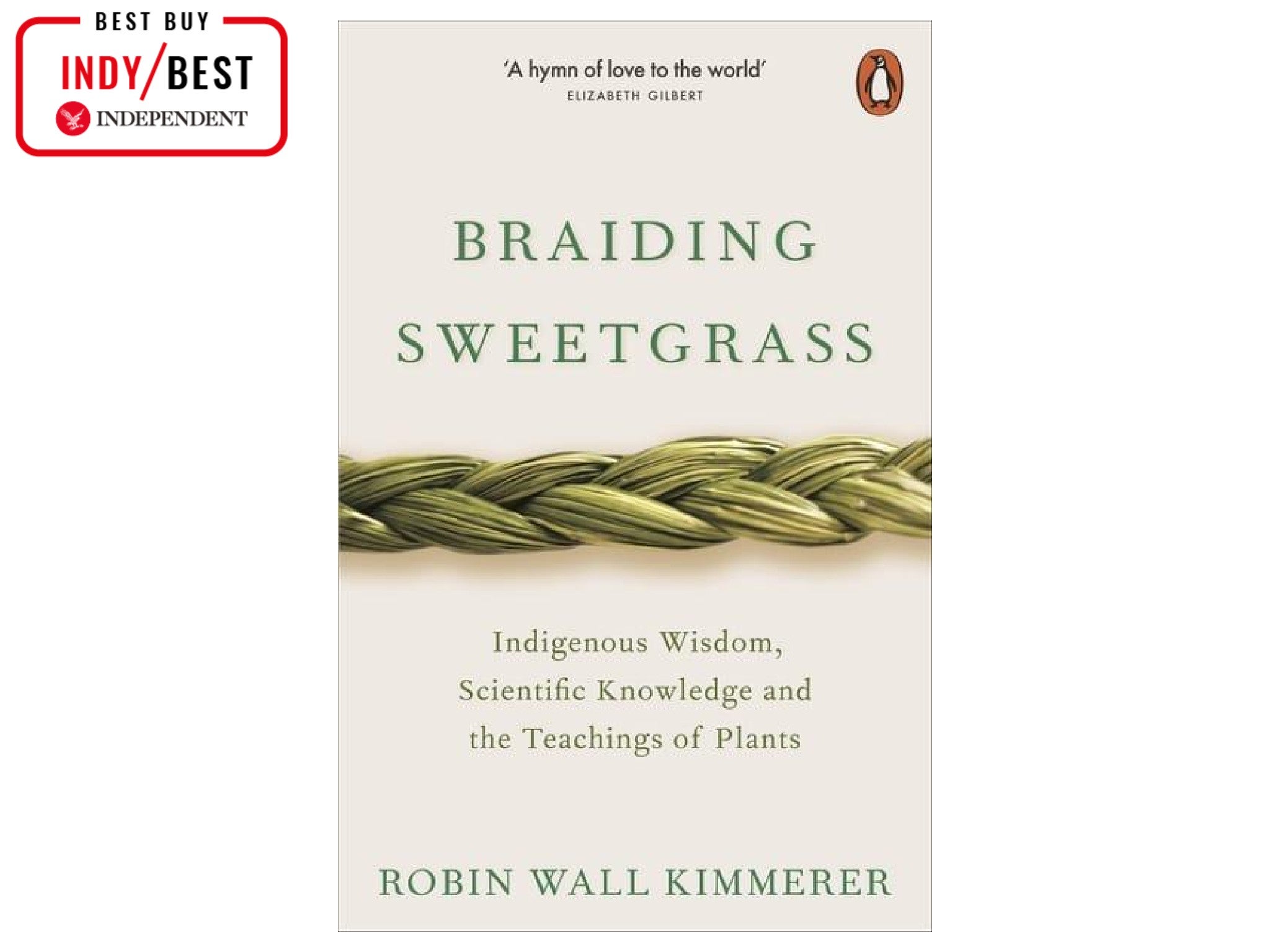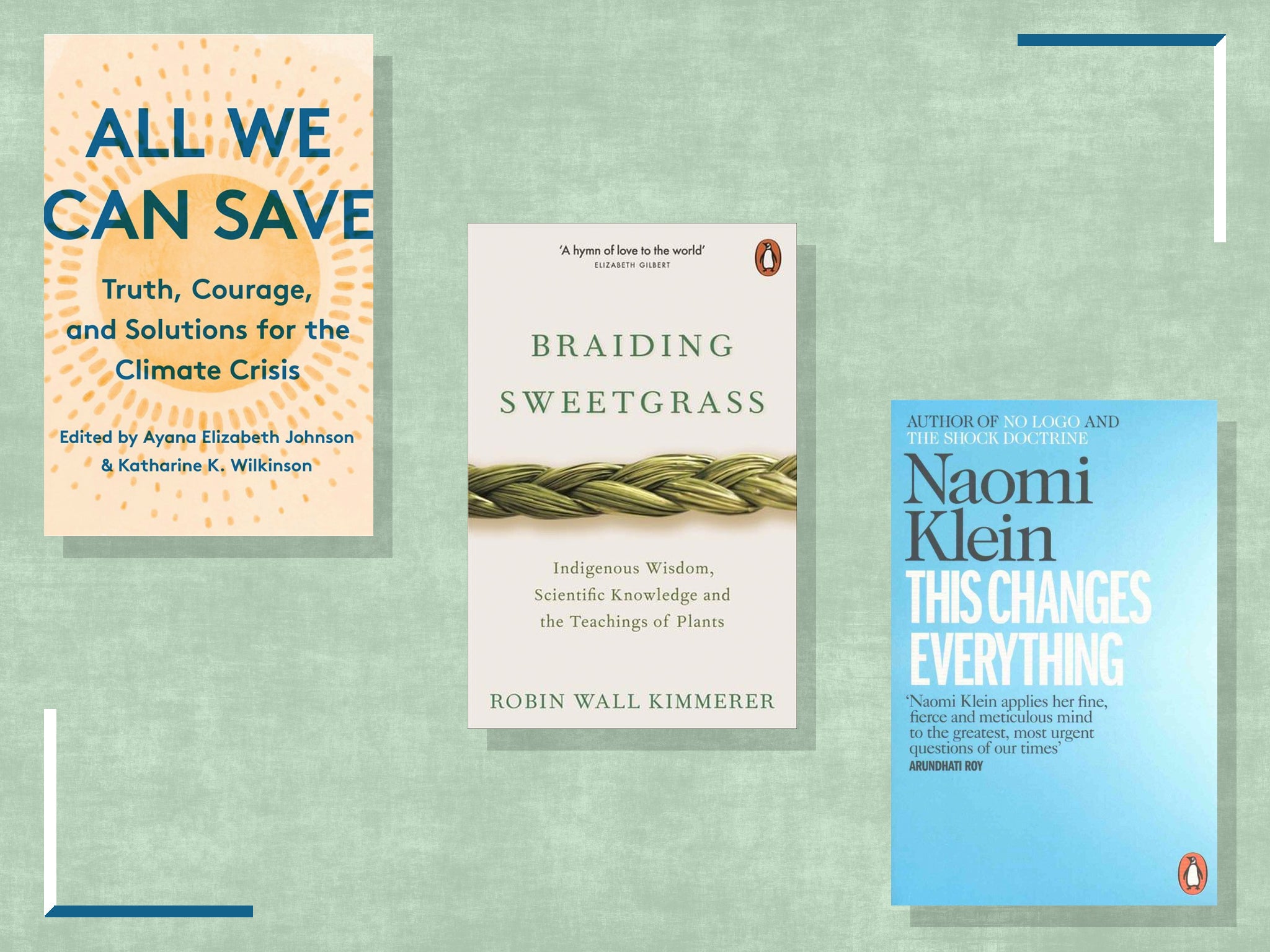
The Independent's journalism is supported by our readers. When you purchase through links on our site, we may earn commission. Why trust us?
8 best climate emergency books that help you to understand the crisis
The clock is ticking for the environment, but these must-read titles will empower you with the knowledge you need to act

 ‘Braiding Sweetgrass: Indigenous Wisdom, Scientific Knowledge, and the Teachings of Plants’ by Robin Wall Kimmerer, published by PenguinRead review£8
‘Braiding Sweetgrass: Indigenous Wisdom, Scientific Knowledge, and the Teachings of Plants’ by Robin Wall Kimmerer, published by PenguinRead review£8
 ‘Small is Beautiful: A Study of Economics as if People Mattered’ by Ernst F Schumacher, published by VintageRead review£8
‘Small is Beautiful: A Study of Economics as if People Mattered’ by Ernst F Schumacher, published by VintageRead review£8
 ‘All We Can Save’ by Ayana Elizabeth Johnson and Katharine K Wilkinson, published by PenguinRead review£16
‘All We Can Save’ by Ayana Elizabeth Johnson and Katharine K Wilkinson, published by PenguinRead review£16 ‘Drawdown: The Most Comprehensive Plan Ever Proposed to Reverse Global Warming’ by Paul Hawkin, published by Penguin BooksRead review£15
‘Drawdown: The Most Comprehensive Plan Ever Proposed to Reverse Global Warming’ by Paul Hawkin, published by Penguin BooksRead review£15 ‘The Uninhabitable Earth: Life After Warming’ by David Wallace-Wells, published by Tim Duggan BooksRead review£8
‘The Uninhabitable Earth: Life After Warming’ by David Wallace-Wells, published by Tim Duggan BooksRead review£8 ‘Doughnut Economics: Seven Ways to Think Like a 21st-Century Economist’ by Kate Raworth, published by Chelsea Green PublishingRead review£7
‘Doughnut Economics: Seven Ways to Think Like a 21st-Century Economist’ by Kate Raworth, published by Chelsea Green PublishingRead review£7
Today is Earth Day 2022 – which means the current climate crisis is under the spotlight as we strive to cut net zero greenhouse emissions down to zero. So where are we now?
Well, here we are – over two years into the pandemic. No one wants to be the bearer of more bad news, but while we were at home, the climate emergency did not stop. In fact, we now know that the fall in carbon emissions is likely to have had very little effect on overall climate goals.
Instead, during the “Great Pause”, we witnessed the second hottest year on record, apocalyptic wildfires spread throughout Australia and California, hurricanes hit Central America and the Gulf Coast, and the volume of Arctic sea ice reached a record low. Biodiversity is still in freefall, deforestation is on the rise, and we aren’t anywhere near close enough to meeting the modest carbon targets of the Paris Agreement.
But enough is enough. Progress doesn’t come from focusing on the problems – it comes from awareness that leads to solutions.
And recently, we’ve had plenty of those too. From innovation in renewable energy, to promises to ban the sale of diesel and petrol cars by 2030, to a surge of spending to protect natural ecosystems – could it be that we’re making tracks to turn this around?
Read more:
The only way to know is to arm yourself and self-educate. Because with pressure comes greenwashing, and this year you’re going to be hearing from plenty of companies and politicians who claim to have ecological wellbeing at heart.
We’ve rounded up our eight favourite books to help widen your perspective and deepen your knowledge of where we are now, and where we need to go to fix the climate crisis.
‘Braiding Sweetgrass: Indigenous Wisdom, Scientific Knowledge, and the Teachings of Plants’ by Robin Wall Kimmerer, published by Penguin

Robyn Wall Kimmerer’s 2013 bestseller has gained a lot of popularity in recent years thanks to heartfelt reviews from across the world. Sharing her evocative perspective, as a botanist and a member of the Citizen Potawatomi Nation, Wall Kimmener is informed by both western science and the teachings of her indigenous ancestors.
This makes for some deliciously entrapping descriptions that reframe our relationship with life on this planet and explain how western perspectives that have dominated decades of “development” are missing out on something fundamental. Discover what everyone is talking about and get lost inside a delectable world that will encourage compassion and curiosity for everything that nature provides.
'This Changes Everything’ by Naomi Klein, published by Penguin

You may have heard ofShock Doctrine and No Logo, but it’s in This Changes Everything that Naomi Klein really gets to the crux of the defining issue of our time. Sharing how we don’t have a carbon problem, but a capitalism problem, Klein exposes the myths in the climate debate, and explains how we already know how to do things like get away from fossil fuels – the problem is that it disturbs our thirst for endless economic growth.
If you’re craving a deeper fix and an explanation of what real systems change could look like, this is it. This Changes Everything takes you all the way through the problem to land on real-life examples of how humanity is rising to the challenge – all across the world.
‘Small is Beautiful: A Study of Economics as if People Mattered’ by Ernst F Schumacher, published by Vintage

The original eco-bible, Small is Beautiful paved the way for today’s books on environmentalism and micro-economics. Schumacher’s detailed collection of essays was published in 1973, right when the energy crisis hit, and has become ever-more relevant since. His straightforward message is that we must stop mindless consumption and “gigantism”, and build our economic systems around communities, not corporations.
This book is the perfect introduction to environmental politics and economics for someone who has never read anything of the sort. Small is Beautiful will open your eyes to why mass-everything was never a good idea and why, decade after decade, our inclination for small, people-centred systems is something we have to start listening to if we want to survive.
‘The End of Nature’ by Bill McKibben, published by Bloomsbury

McKibben’s classic work on the environmental crisis makes a passionate plea for a fundamental philosophical shift in the way we relate to nature. He outlines how we need to stop seeing nature as this romantic force, independent of humans. Once it was, but now our imprint on the natural world is so strong that our need to take action is fundamental for survival. If you still need to convince a friend or relative that climate change is real, I would start here. Detailed science through a powerful soulful lens,The End of Nature is our manual for change.
‘All We Can Save’ by Ayana Elizabeth Johnson and Katharine K Wilkinson, published by Penguin

This 2020 collection of essays came at just the right point. Bringing together a diverse collection of women’s voices – scientists, journalists, farmers, lawyers, teachers – the book highlights how women are leading the fight against the climate crisis, but still not enough of us are in leadership.
The book manages to address serious topics with the love and compassion that we so desperately need and actually leaves the reader feeling hopeful, which seems like a rarity these days. Read this book and you’ll gain a spectrum of ideas and insights on how we can radically reshape society and move forward on a path towards all that we can save.
‘Drawdown: The Most Comprehensive Plan Ever Proposed to Reverse Global Warming’ by Paul Hawkin, published by Penguin Books

In the face of climate doom and fear-spreading, Drawdown is the manual to read and reread to arm yourself with tangible data. The book is the culmination of a project led by activist and entrepreneur Paul Hawken, which started in 2013 and has since brought together more than 65 researchers from across the globe with 128 experts in climate, sustainability, academia, and business.
From commonly known solutions such as using solar energy in cities, to those more nuanced and with a social basis, this book lays out 100 solutions to help us reach “drawdown” – the point in time when greenhouse gases in the atmosphere peak and begin to decline. This run-through will make you feel super-smart and empowered, and provides plenty of material to share in those difficult conversations with sceptics and apathists.
‘The Uninhabitable Earth: Life After Warming’ by David Wallace-Wells, published by Tim Duggan Books

Feel like you need to go to the depths of what is happening and what is to come? Look no further. The Uninhabitable Earth reads as a travelogue of the near future, explaining how the lives of billions of humans are changing and will continue to change – drastically. It shows head-on how our anxieties about things like rising sea levels barely scratch the surface.
This frank and unapologetic wake-up call skips the scientific jargon and delivers the facts in urgent, elegant prose that explains how what’s coming will cause an all-encompassing shift in politics, culture, sense of history – everything. With the first line, “It is, worse, much worse, than you think,” this book is not exactly easy reading. However, what it is good for is shaking us out of complacency to understand the effect that our lifestyle is having – now.
‘Doughnut Economics: Seven Ways to Think Like a 21st-Century Economist’ by Kate Raworth, published by Chelsea Green Publishing

Another person-centred account of microeconomics to add to the list, Doughnut Economics is the heralded work of Oxford academic Kate Raworth. It explains how conventional economics has left us with a system that leaves billions stuck in poverty at one end, and endless environmental destruction at the other.
Instead, Raworth’s proposed “doughnut” represents the sweetest system, where it’s possible to meet all of our needs without exhausting the planet. She explains that while we need practical and political reform, we also need a new economic system to make sure that things doesn’t happen again. Read on for an accessible, relatable account that relays academic thinking back to everyday lives and communities.
The verdict: Climate emergency books
While we should cover all bases and get a holistic understanding of the science, economics and social change needed to avoid climate catastrophe– if we don’t reframe the relationship we have with the natural world – will we ever really fix this?
Braiding Sweetgrass by Robin Wall Kimmerer is our number one choice for bringing the reader back to the root cause of climate change – the notion that humans and nature are two seperate things. Go ahead and pore through the pages, see if it doesn’t make you crave a sustainable future where biodiversity begins to rise, everyone has access to clean water, and we grow food in a way that repairs ecosystems and strengthens communities.
Voucher codes
For the latest discounts on audiobooks, try the link below:
For more top reads, look to our review of the best books to help you live more sustainably
